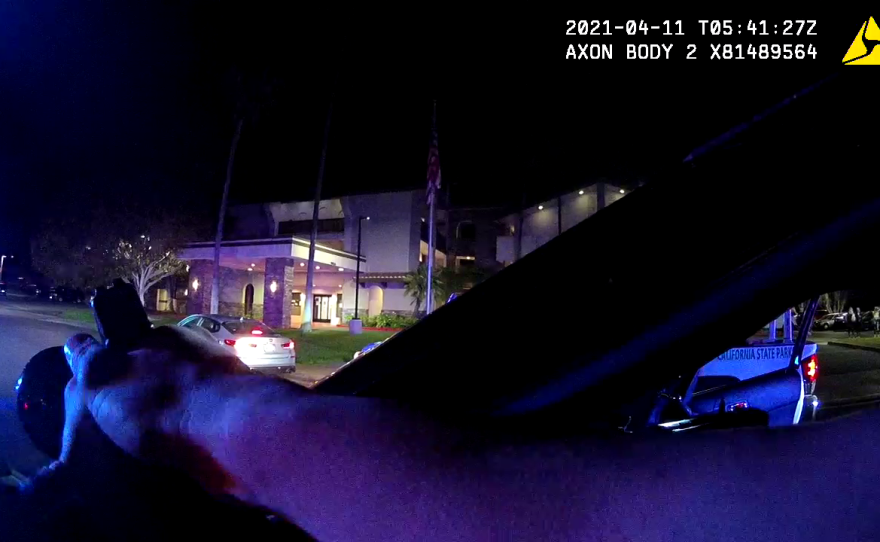On a Saturday night in April 2021, Carlsbad Police Officer Jordan Walker was searching for a stolen Kia SUV in an area of town next to Interstate 5 known as a hotspot for crime.
He spotted the car being driven by a woman with a male passenger. He pulled them over and asked the woman to get out of the car.
When she refused, Walker called for backup and six police officers arrived at the scene. Officers then asked the male passenger to exit the car, which he did. But when they tried to handcuff him, he fought back. Officers then tackled him to the ground and punched him repeatedly.
Meanwhile, an officer fired a beanbag gun at the car and officers fired a total of 57 pepper balls at the woman while she was in the car and after she jumped out and began to run. They ended up tackling and arresting her inside a nearby hotel.
As far as police use-of-force incidents go, this one was not all that unusual — police in San Diego County and elsewhere regularly use nonlethal force like beanbag guns, tasers and pepper balls to subdue suspects.
However, what was unusual were the actions by the Carlsbad Police Department following the incident. Even though there were no complaints from the public, the department disciplined the officers for violating its policy on nonlethal force, de-escalation and supervision responsibility.
The investigation
The internal affairs investigation determined that officers involved in the incident were justified in using force, but found that Corporal Derek Harvey and Officer Edward Ramirez shouldn’t have used the beanbags and pepper balls unless the suspect was armed or otherwise a violent threat.
“The officer using the pepper ball gun was out of compliance for firing pepper ball rounds that struck the female even though she wasn't armed or a violent threat,” said Asst. Chief Christie Calderwood.

The review also faulted their supervisor, Sgt. Morgan Griggs, for not de-escalating the situation and coming up with a plan for arresting the driver if she came out of the car. It also found that Lt. Greg White, the supervising watch commander, “actually did not show up on scene, which was very concerning for us, and he ended up leaving the force shortly after that,” Calderwood said.
White’s recommended discipline was to be demoted to a sergeant, but instead he retired, Calderwood said.
This is not a typical department response to a use of force case in San Diego County. Just 3% of local officers who used enough force to cause severe injury received any discipline, according to a KPBS analysis of 475 use-of-force incidents dating back to 2000.
The department also wrote new training procedures for using bean bag guns and pepper balls and reached out to community groups for input on a new de-escalation policy and a new de-escalation training program.
“We didn't just take the step of providing additional training to the officers involved, we said, ‘let's cover the entire department,’” Calderwood said.
After the internal affairs review, Harvey, Ramirez and Griggs negotiated reduced suspensions in settlement hearings between their union and the city.
Griggs was originally suspended for 80 hours, but the suspension was reduced to 40 hours. Harvey's 80-hour suspension was reduced to 12 hours, plus eight hours lost vacation. Ramirez was originally suspended for 40 hours but had his reduced to 20 hours. Walker, the original officer on the scene, was not disciplined.
This incident is the only use-of-force incident the department has reported under SB 1421, a state law that went into effect in 2019 that requires police agencies to make public records relating to certain use-of-force incidents.
Working with the community
The department reached out to a number of community groups for input on the de-escalation policy, said Yusef Miller, co-founder of the North County Equity & Justice Coalition.
“We discussed de-escalation policies, we discussed use of force tactics,” Miller said. “And Carlsbad was very amenable to the things that we were talking about. The chief was very accepting, very flexible. His staff was also flexible and understanding.”
He added that the community input on the de-escalation policy allowed people to talk about how they view police practices and what feels like escalation or de-escalation.
“It was a really easy and smooth process, I really enjoyed it,” he said. “We were understood by the police department, they were understood by us and it moved along without a lot of the contention you see in other meetings, people ready to throw shoes and books at each other and all this kind of stuff.”

Aly Vredenburgh, president of the Carlsbad Equality Coalition, said she’s also seen a change in the overall culture of the police department.
“Up until this policy was in place, there was this culture of being more aggressive with use of force,” she said. “Because of this new policy, there's this more moral responsibility to protect everyone that they can. And so it's creating this mindset of reducing harm to everyone and having a reverence for human life.”
All 130 Carlsbad police employees went through the training by the end of 2021, said Lt. Reid Shipley, who designed and led the training.
“One of the things we tried to emphasize is that proper application of de-escalation is in of itself good tactics and also is safer not only for the community but for the officers who are employing these tactics,” Shipley said.
Still, Miller said, none of this would be happening without the murder of George Floyd by Minneapolis Police in the summer of 2020 and the nationwide racial reckoning that followed.
“Before George Floyd, we only got three answers when it came to discussions like this: no, no, and hell no,” he said. “George Floyd was the catalyst to this. Throughout the nation, where cities were burning down, officers were engaged in very aggressive interactions with the community, those are the initiators of such a calm discussion now.”









